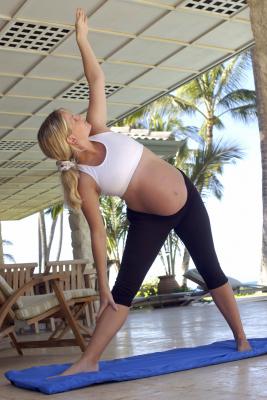A strong, fit body handles the demands of labor more efficiently. Different types of exercises work together to help the body prepare for labor and delivery of the baby. Cardiovascular exercises increase a woman’s endurance so she is better able to work through a long labor. Strength training prepares the muscles for delivering the baby. With a variety of exercises throughout the pregnancy, you’ll have a well-rounded preparation for labor.
Walking
Low-impact aerobic exercises like walking are ideal for pregnant women, particularly those who don’t already have a regular fitness routine. Walking allows you to control your pace, intensity and distance to match your current fitness level. Increase the distance or length of time you walk as your body grows stronger. Walking strengthens the cardiovascular system so you can better handle the intensity of labor. This pregnancy exercise may also help your baby descend, with a little help from gravity. The pressure on the cervix sometimes helps it dilate if your body is ready to go into labor anyway. Walk while in labor helps some women handle the pain and may help the labor progress more quickly.
Yoga
Yoga incorporates many aspects of well-being into one routine, focusing on relaxation and stress relief as well as stretching and strengthening. A pregnant woman faces many stress-inducing situations as labor nears. Yoga helps ease the mind and reduce anxiety about the labor and delivery. Regular yoga practice also strengthens the muscles, particularly the legs and abdomen. Strong muscles in the abdomen help push the baby out during delivery. Strong leg muscles support the extra weight as pregnancy progresses. The breathing practiced during yoga is a potential relaxation tool while a women is in labor. When she uses controlled breathing, she may be better able to handle the pain and intensity of labor.
Kegel Exercises
Kegel exercises focus on the pelvic floor muscles, which contribute to pushing the baby out of the uterus during delivery. Start Kegel exercises early in the pregnancy for the best results. The muscles used to stop urine flow are the same muscles used for Kegel exercises. Women who have difficulty identifying the muscles can insert a finger in the vagina to feel for the squeeze as you contract the muscles. Once you identify the correct muscles, tighten them and hold it for a few seconds. Release the muscles and rest for a few seconds before repeating the move. Do your Kegel exercises a few times a day to continue building the pelvic floor muscles for an easier delivery.
Patterned Breathing
Patterned breathing exercises during labor help you better control the pain and stay more relaxed. Practicing your patterned breathing before you go into labor makes the process more automatic when the contractions begin. When applying the breathing to labor, take a deep breath at the beginning of each contraction. A slow breathing pattern might help initially. Inhale through the nose and breathe out through your mouth. When the contractions become more intense, quick, light breathing is often more effective. Breathe in and out through the mouth quickly with shallow breaths. Some laboring women prefer variable breathing, which uses several short, shallow breaths followed by a longer, deeper breath. This pattern repeats through the contraction. Light stroking of your arms, legs and back and moving around during the contractions complement the patterned breathing as effective tools to diminish labor intensity. Many mothers also find that after the baby is born, patterned breathing helps them deal with stress in everyday life.





